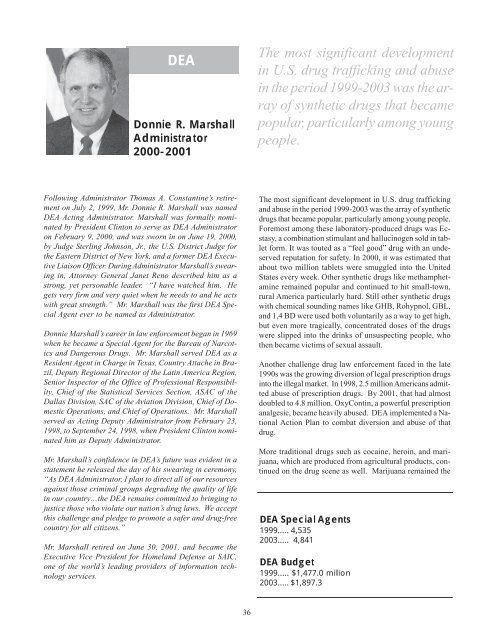Download This File - The Free Information Society
Download This File - The Free Information Society
Download This File - The Free Information Society
You also want an ePaper? Increase the reach of your titles
YUMPU automatically turns print PDFs into web optimized ePapers that Google loves.
DEA<br />
Donnie R. Marshall<br />
Administrator<br />
2000-2001<br />
Following Administrator Thomas A. Constantine’s retirement<br />
on July 2, 1999, Mr. Donnie R. Marshall was named<br />
DEA Acting Administrator. Marshall was formally nominated<br />
by President Clinton to serve as DEA Administrator<br />
on February 9, 2000, and was sworn in on June 19, 2000,<br />
by Judge Sterling Johnson, Jr., the U.S. District Judge for<br />
the Eastern District of New York, and a former DEA Executive<br />
Liaison Officer. During Administrator Marshall’s swearing<br />
in, Attorney General Janet Reno described him as a<br />
strong, yet personable leader. “I have watched him. He<br />
gets very firm and very quiet when he needs to and he acts<br />
with great strength.” Mr. Marshall was the first DEA Special<br />
Agent ever to be named as Administrator.<br />
Donnie Marshall’s career in law enforcement began in 1969<br />
when he became a Special Agent for the Bureau of Narcotics<br />
and Dangerous Drugs. Mr. Marshall served DEA as a<br />
Resident Agent in Charge in Texas, Country Attache in Brazil,<br />
Deputy Regional Director of the Latin America Region,<br />
Senior Inspector of the Office of Professional Responsibility,<br />
Chief of the Statistical Services Section, ASAC of the<br />
Dallas Division, SAC of the Aviation Division, Chief of Domestic<br />
Operations, and Chief of Operations. Mr. Marshall<br />
served as Acting Deputy Administrator from February 23,<br />
1998, to September 24, 1998, when President Clinton nominated<br />
him as Deputy Administrator.<br />
Mr. Marshall’s confidence in DEA’s future was evident in a<br />
statement he released the day of his swearing in ceremony,<br />
“As DEA Administrator, I plan to direct all of our resources<br />
against those criminal groups degrading the quality of life<br />
in our country…the DEA remains committed to bringing to<br />
justice those who violate our nation’s drug laws. We accept<br />
this challenge and pledge to promote a safer and drug-free<br />
country for all citizens.”<br />
Mr. Marshall retired on June 30, 2001, and became the<br />
Executive Vice President for Homeland Defense at SAIC,<br />
one of the world’s leading providers of information technology<br />
services.<br />
36<br />
<strong>The</strong> most significant development<br />
in U.S. drug trafficking and abuse<br />
in the period 1999-2003 was the array<br />
of synthetic drugs that became<br />
popular, particularly among young<br />
people.<br />
<strong>The</strong> most significant development in U.S. drug trafficking<br />
and abuse in the period 1999-2003 was the array of synthetic<br />
drugs that became popular, particularly among young people.<br />
Foremost among these laboratory-produced drugs was Ecstasy,<br />
a combination stimulant and hallucinogen sold in tablet<br />
form. It was touted as a “feel good” drug with an undeserved<br />
reputation for safety. In 2000, it was estimated that<br />
about two million tablets were smuggled into the United<br />
States every week. Other synthetic drugs like methamphetamine<br />
remained popular and continued to hit small-town,<br />
rural America particularly hard. Still other synthetic drugs<br />
with chemical sounding names like GHB, Rohypnol, GBL,<br />
and 1,4 BD were used both voluntarily as a way to get high,<br />
but even more tragically, concentrated doses of the drugs<br />
were slipped into the drinks of unsuspecting people, who<br />
then became victims of sexual assault.<br />
Another challenge drug law enforcement faced in the late<br />
1990s was the growing diversion of legal prescription drugs<br />
into the illegal market. In 1998, 2.5 million Americans admitted<br />
abuse of prescription drugs. By 2001, that had almost<br />
doubled to 4.8 million. OxyContin, a powerful prescription<br />
analgesic, became heavily abused. DEA implemented a National<br />
Action Plan to combat diversion and abuse of that<br />
drug.<br />
More traditional drugs such as cocaine, heroin, and marijuana,<br />
which are produced from agricultural products, continued<br />
on the drug scene as well. Marijuana remained the<br />
DEA Special Agents<br />
1999..... 4,535<br />
2003..... 4,841<br />
DEA Budget<br />
1999..... $1,477.0 million<br />
2003..... $1,897.3

















